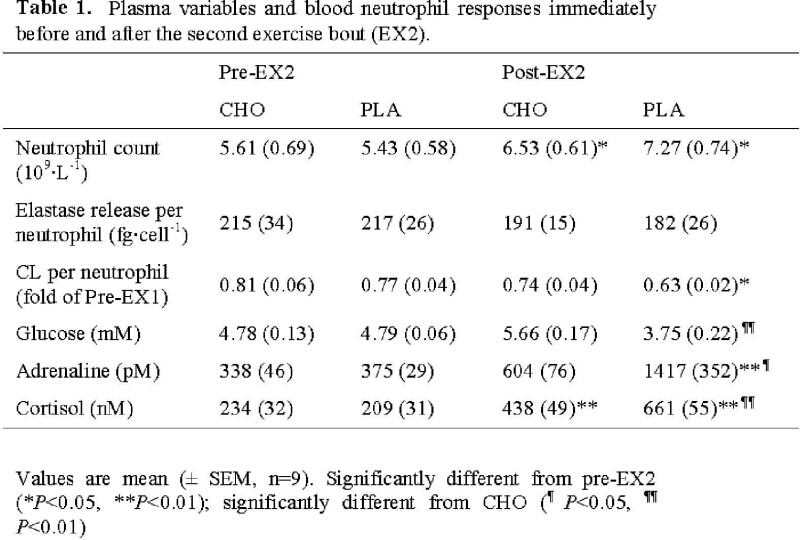It has been demonstrated that carbohydrate ingestion, compared with placebo, during a 3-h recovery interval between two bouts of prolonged exercise had only a limited effect on perturbation of blood neutrophil numbers and function during the second exercise bout although some attenuation of hypothalamic-pituitary-adrenal (HPA) axis activation occurred (Li and Gleeson, 2004). The aim of the present study was to determine the effect of carbohydrate supplementation during the second of two prolonged cycling bouts on neutrophil responses. With Loughborough University Ethics Committee approval, nine males (age 28.7 ± 1.6 years, body mass 74.4 ± 3.2 kg, VO2max 50.3 ± 2.4 mL.kg-1.min-1; means ± SEM) performed two bouts of 90 min cycling (EX1 started at 09:00 and EX2 started at 13:30) at 60% VO2max after an overnight fast on two occasions, separated by at least 4 days in a randomised order. Subjects consumed 500 mL of a carbohydrate (10% w/v glucose; CHO) or placebo (PLA) beverage at 5-min pre-exercise and 250 mL every 20 min during the second exercise bout. Water ingestion was allowed ad libitum during the first exercise bout and recovery interval. Venous blood samples were collected at pre-exercise and post-exercise for both bouts. Haematological analysis was performed using an automated cell counter. Plasma hormone concentrations were determined using ELISA kits. Phorbol myristate acetate induced oxidative burst activity was measured using a chemiluminescence (CL) assay (Knight Scientific Limited, Plymouth) and bacterially-stimulated neutrophil degranulation was measured as described by Robson et al. (1999). Results were analysed using a two-factor (trial × time) repeated measures ANOVA with post hoc Tukey tests and paired t tests applied where appropriate. The ingestion of CHO compared with PLA during the second exercise bout had no effect on blood neutrophil count, degranulation and oxidative burst responses although the plasma glucose concentration was better maintained (P<0.01) and plasma concentrations of adrenaline (P<0.05) and cortisol (P<0.01) were blunted (Table 1). These findings suggest CHO feeding during the second of two bouts of 90 min cycling at 60% VO2max maintains better CHO availability, blunts HPA activation, but does not affect blood neutrophil count or function at immediate cessation of exercise.
King's College London (2005) J Physiol 565P, PC12
Communications: Effects of carbohydrate supplementation during the second of two prolonged cycling bouts on blood neutrophil responses
Li, Tzai-Li ; Gleeson, Mike ;
1. Department of Sports and Leisure Studies, National Dong Hwa University, Hualien 97401, Taiwan. 2. School of Sport and Exercise Sciences, Loughborough University, Loughborough LE11 3TU, United Kingdom.
View other abstracts by:
Where applicable, experiments conform with Society ethical requirements.

